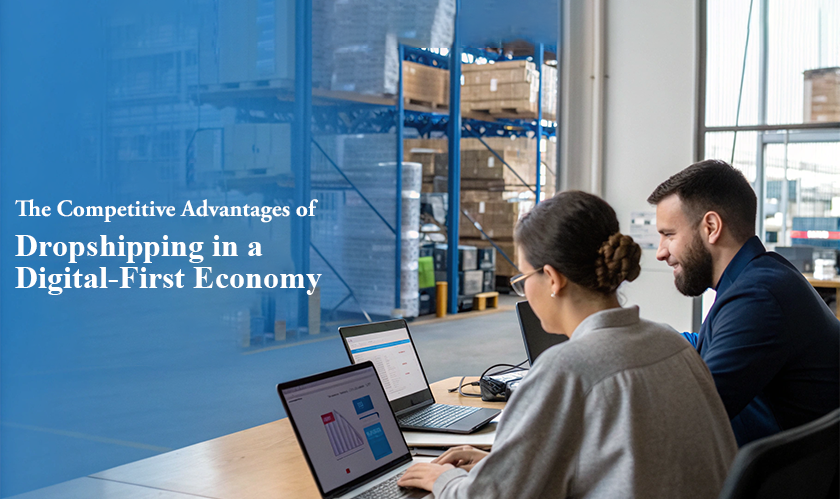Home Industry Digital marketing The Competitive Advantages of ...
Digital Marketing

CIO Bulletin
18 November, 2025
Dropshipping has evolved from a niche eCommerce tactic into a core strategy for digital-first businesses navigating rapid market shifts. In 2026, its advantages are no longer defined merely by low barrier to entry or minimal inventory risk. Instead, dropshipping has become a model for operational agility, the currency of competitive survival in a world where consumer behavior, supply chains, and marketing algorithms change by the month.
The digital-first economy rewards speed, data literacy, and flexible logistics. Dropshipping, when executed with automation and modern supplier networks, aligns directly with those demands.
A Business Model Built for Agility
In traditional retail, inventory binds a business to risk. Excess stock can sink margins, and slow-moving inventory drains capital. Dropshipping removes that constraint entirely. Without the need to purchase or store inventory, companies can shift products, categories, and suppliers at the pace of demand.
This flexibility has become more valuable as consumer trends become increasingly volatile. According to McKinsey’s 2025 Global Consumer Pulse survey, 42% of online shoppers frequently switch product categories based on social media trends, up from just 23% in 2020. Sellers tethered to static inventory struggle here. Dropshipping businesses do not.
By operating without physical stock, dropshippers can rapidly test new niches, respond to emerging trends, and abandon underperforming items without financial drag. In a digital-first landscape where time-to-market defines profitability, this structural fluidity is a significant competitive advantage.
Automation Enhances Operational Efficiency
What truly differentiates modern dropshipping from its 2018-era counterpart is automation.
AI-driven tools and integrated supply chains now handle much of the repetitive work that once limited scalability:
syncing supplier inventory
adjusting pricing based on competition or margin goals
routing orders instantly
generating optimized listing titles using natural language models
tracking delivery and exception handling
According to the 2025 Commerce Signals Infrastructure Study, eCommerce sellers using automated fulfillment workflows achieved 43% lower operating costs and processed orders 50–120% faster than non-automated businesses.
Tools like Easync, AutoDS, and Syncee have turned dropshipping into a high-efficiency system that requires less manual intervention and provides more consistent accuracy than many traditional fulfillment models. Automation reduces human error, minimizes overselling, and allows even small teams to manage thousands of listings across multiple platforms.
In the digital-first economy, where consumers expect real-time updates and next-day delivery — automation is not simply an upgrade; it is a competitive imperative.
Global Reach Without Infrastructure Investment
Another key advantage is the built-in international scalability. Traditional expansion into new markets requires warehousing, shipping infrastructure, regulatory navigation, and significant capital investment. Dropshipping bypasses these constraints by leveraging global supplier networks and region-specific fulfillment centers.
In 2025, the World Retail Logistics Report noted that cross-border eCommerce grew 17% year-over-year, driven largely by lightweight fulfillment models and localized shipping partners. Dropshipping businesses benefit disproportionately from this shift, accessing the same international markets that previously favored large, logistics-heavy retailers.
Moreover, the rise of regional suppliers in the UK, EU, US, and Australia has shortened delivery times significantly. Sellers who previously relied on long-distance Chinese suppliers can now access domestic providers with two- to four-day shipping windows — enabling competitive parity with mainstream eCommerce brands.
This democratization of global logistics makes dropshipping a viable model not only for startups but also for established retailers seeking rapid market deployment without long-term infrastructure commitments.
Cost Efficiency in an Inflationary World
The past four years have reshaped the financial landscape for small and midsized retailers. Storage, shipping, packaging, and labor costs have risen across all major markets, squeezing traditional retail margins.
Dropshipping, however, remains resilient. By eliminating warehousing, bulk purchasing, and return-processing overhead, dropshippers reduce financial exposure during inflationary cycles. The 2025 OECD Retail Cost Index shows that traditional retailers experienced average cost increases of 11.4%, while dropshipping operations rose by only 3.1%, largely due to stable platform-based fulfillment systems.
This cost efficiency becomes a strategic advantage in a digital-first economy where profitability hinges on lean operations and the ability to pivot quickly under fluctuating cost conditions.
Data as the New Supply Chain
In many ways, dropshipping is the purest expression of data-driven retail. Sellers succeed not by owning product but by understanding demand — what sells, to whom, and why.
Modern dropshipping businesses use analytics to monitor:
keyword search volume
social trend acceleration
supplier performance metrics
conversion funnels
shipping time accuracy
This data-first mindset aligns perfectly with the expectations of contemporary eCommerce. Instead of managing physical inventory, sellers manage information.
Tech-forward dropshippers now use predictive analytics to forecast demand and automate product rotation. AI tools evaluate supplier reliability, delivery performance, and product quality scores before items are even listed.
The result is a more responsive, resilient business model that can adapt faster than traditional retail operations tied to physical stock cycles.
Built for a Platform-Dominated Retail Environment
The digital-first economy is dominated by marketplaces like Amazon, eBay, Walmart Marketplace, and TikTok Shop — all of which reward sellers who can consistently meet performance metrics.
Dropshipping, supported by automation, enables sellers to meet these standards:
fast listing creation
dynamic repricing
stock accuracy
on-time fulfillment
rapid customer service response
Because operational complexity is outsourced to suppliers and software, sellers can focus on optimizing the variables that marketplaces measure most heavily conversion rates, feedback scores, and shipping reliability.
This alignment with platform priorities gives dropshipping an advantage that traditional fulfillment models struggle to match.
Conclusion: The Model That Matches the Moment
The competitive advantages of dropshipping in 2026 are not the same ones that drove its early popularity. Today, dropshipping fits the digital-first economy because it is agile, low-risk, and deeply compatible with automation and global logistics infrastructure.
It is a model that rewards fast learning, data fluency, and strategic adaptability — traits that define the winners in modern eCommerce.
As supply chains become smarter, software becomes more integrated, and markets evolve more rapidly, dropshipping continues to offer a structural edge: the ability to scale a business without scaling its liabilities.
For operators equipped with the right tools and a data-driven mindset, dropshipping remains not just viable, but competitively advantaged in ways traditional retail can no longer match.







